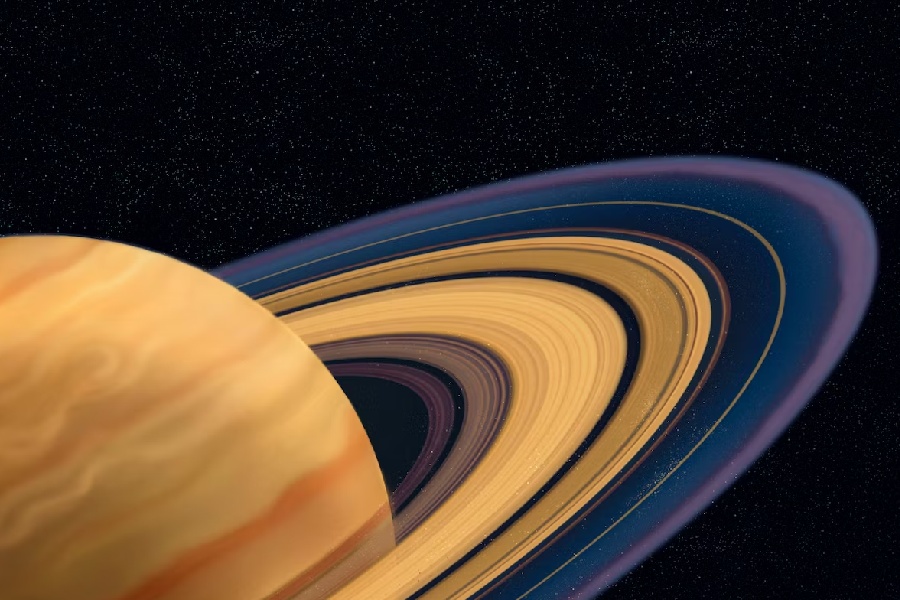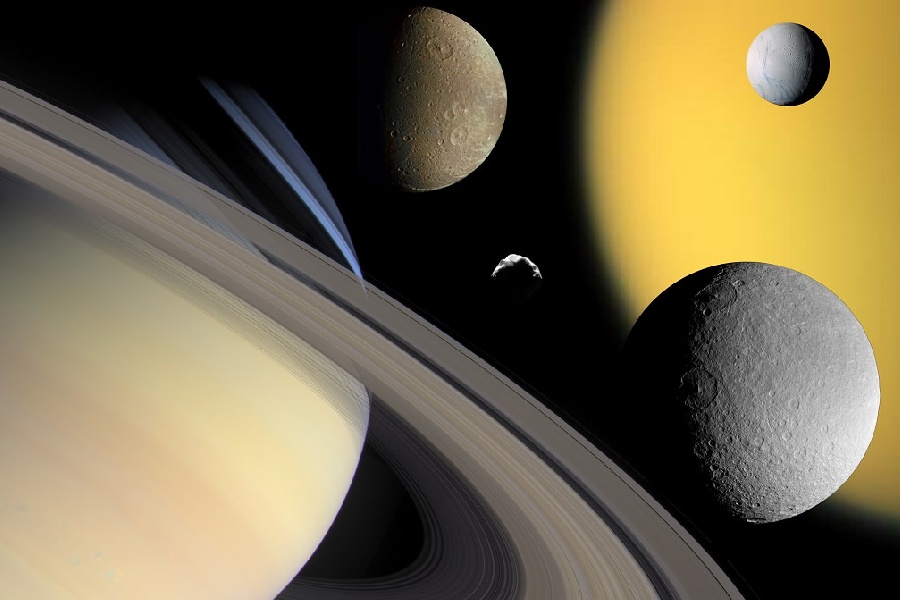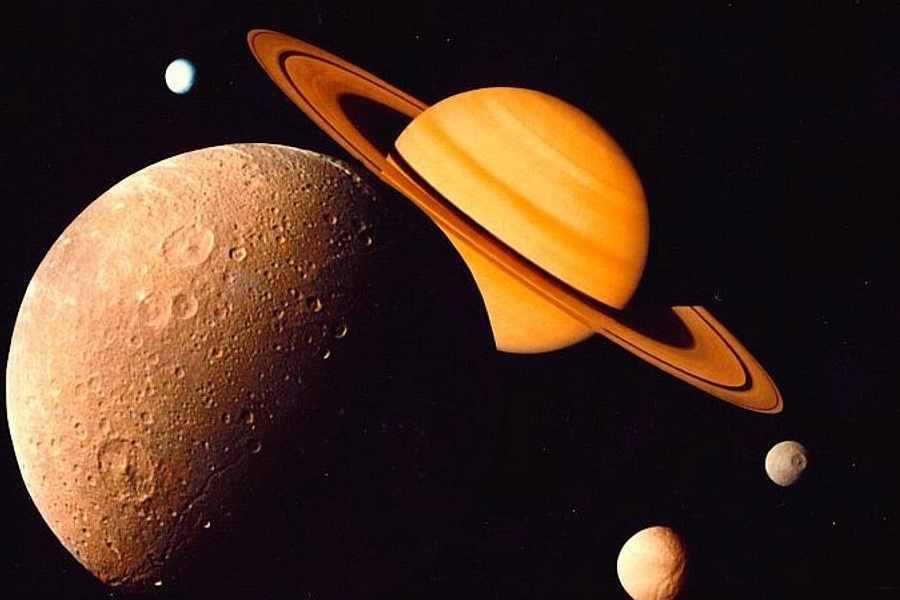Saturn, the majestic gas giant of our solar system, looms in the distant reaches of space, its stunning rings and golden hue capturing the imagination. Yet beneath its mesmerizing appearance lies a fundamental question – is Saturn a frigid ice giant like Uranus and Neptune, or does it possess a searing, Venus-like heat?
With its remote orbit far from the Sun’s warmth, Saturn would seem destined to be a perennially frozen world. Yet Saturn harbors hot spots fierce enough to melt metal and raging storms that whip heat around the planet. So is Saturn cold or hot? Like Saturn’s enigmatic rings, the answer is more complex than it first appears.
What could drive temperatures on a faraway planet like Saturn to such astonishing heights? Are its tropical zones truly Earth-hot? Does Saturn’s core sizzle hotter than the Sun?
To unravel the mysteries behind Saturn’s unexpected heat, we will explore the forces that generate temperature extremes on this cryptically cold planet. Join us as we investigate the cosmic furnace hidden beneath Saturn’s mask of ice and clouds.
Is Saturn Cold or Hot?
Is Saturn cold or hot? Saturn, like other gas giant planets, has a complex temperature profile. While its upper cloud layers are extremely cold, with temperatures dropping to about -285°F(-175°C), the planet’s interior is incredibly hot.
Saturn’s core temperature can reach thousands of degrees, making it hotter than the surface of the Sun. So, in a sense, Saturn is both cold and hot, depending on the depth within the planet’s atmosphere or its core that you’re considering.

Surface and interior temperatures
Saturn is a gas giant planet, meaning it has no solid surface. But deep down, at Saturn’s rocky core, temperatures likely reach 11,700°F, hotter than the Sun’s surface at 9,900°F.
This internal heat comes from gravitational compression and the decay of radioactive elements. Just below Saturn’s cloud tops, temperatures increase rapidly from the cold upper atmosphere to over 70°F around 100 miles deep due to compression of atmospheric gases.
Atmospheric temperature profile
Saturn’s atmosphere shows a distinct temperature profile:
- The uppermost clouds are freezing at -280°F
- Near the core, extreme pressures boost temperatures to over 11,000°F
- Powerful winds also whip heat around the planet, creating local hot spots
So while its cloudy upper atmosphere is frigidly cold, Saturn harbors extreme heat hidden from view in its deep interior and lower atmosphere, demonstrating Saturn’s temperature extremes.
Interior of Saturn
Heat generation and gravitational compression
Saturn’s sky-high interior temperatures are created through two key processes:
Gravitational compression
Gravitational compression of the planet’s mass generates tremendous heat. The huge gravitational force from Saturn’s mass pulls inward and compresses the inside of the planet intensely.
This compression converts Saturn’s gravitational potential energy into thermal energy, producing prodigious heat. Studies suggest over half of Saturn’s heat comes from gravitational compression.
Radioactive decay
Radioactive decay of elements inside Saturn also generates high temperatures. Although Saturn is mostly hydrogen and helium, it contains heavier elements closer to the core.
Radioactive isotopes like uranium-238, uranium-235, thorium-232, potassium-40, and rubidium-87 naturally decay radioactively, releasing energy in the form of heat. The decay of these radioactive substances, especially the more abundant uranium and thorium, adds to the internal heat.
Together, these two processes – gravitational compression and radioactive decay – generate the enormous heat energy radiating from Saturn’s core outward, despite the planet’s distance far from the Sun. This empowers Saturn with its raging hot interior that defies its frozen exterior.
Core temperature and conditions
At Saturn’s core, temperatures reach an extreme 11,700°F, even hotter than the surface of the Sun at 9,900°F. This represents the peak of Saturn’s internal heat. The core has an estimated mass of around 25 Earths and a density similar to Earth’s, suggesting a composition primarily of iron, nickel, silicon, and oxygen.
The intense heat and immense pressures at Saturn’s center cause the hydrogen gas surrounding the core region to transition into a liquid metallic state.
This allows Saturn to maintain a solid core despite being a gas giant overall. The conditions in Saturn’s inner depths are truly remarkable, unlike anywhere else in the solar system.

Contrasting the Extremes
Comparing surface to core temperatures
The temperature difference between Saturn’s upper clouds and its core is staggeringly extreme. The uppermost cloud layers on Saturn have temperatures around -280°F due to their great distance from the Sun’s heating influence.
However, deep beneath the clouds, at Saturn’s central core, temperatures skyrocket to over 11,000°F, hotter than the surface of the Sun! This incredible temperature differential is made possible by Saturn’s internal heat generation and the rapid compression of atmospheric gases closer to the planet’s center.
While the upper atmosphere is exposed to the cold of space, around 31,000 miles down into Saturn’s interior, tremendous pressures boost temperatures over 1,000 degrees higher. The further down towards the core, the hotter it gets, showcasing the sheer extremes that can exist between Saturn’s frigid exterior and its sweltering interior furnace.
Factors influencing Saturn’s temperature profile
- Distance from the Sun creates a cold upper atmosphere yet allows retention of internal heat
- Gravitational compression and radioactive decay drive high internal temperatures
- Atmospheric circulation patterns distribute heat unevenly around the planet
- Saturn emits 2.5 times more heat than it receives from the Sun due to internal processes
These facts show Saturn’s incredibly varied temperature profile, from its frigid upper clouds to the scorching heat of its hidden core.
Exploring Saturn’s Seasons
Impact of Saturn’s axial tilt
With an axial tilt of 26.7 degrees, similar to Earth’s 23.5-degree tilt, Saturn does experience seasons as it orbits the Sun. However, Saturn’s year lasts 29 Earth years due to its much farther orbit from the Sun.
As a result, Saturn’s seasons are dramatically longer, each persisting for over seven years before transitioning to the next season. This extreme seasonal variation leads to unusual temperature effects.
On Earth, seasons last three months. But on Saturn, the pole tilted toward the Sun has a prolonged summer with constant sunlight for nearly a third of Saturn’s orbit. This allows for dramatic summertime heating over the years.
Meanwhile, the opposite pole endures years of darkness in a lengthy winter, leading to extreme cold. Saturn’s warmer, more moderate spring and fall seasons are very brief, lasting only a couple of Earth years each between the temperature extremes.
Variations in temperature throughout the year
During a summer in Saturn’s southern hemisphere, which lasted from 2002 to 2010, temperatures at the south pole reached a balmy 80°F thanks to continuous sunlight bathing it for over seven years straight. This is over 30 degrees warmer than Saturn’s equator.
In contrast, Saturn’s north pole undergoes a dark, bitter winter for over a quarter of Saturn’s orbital period.
Frigid temperatures plunge below -285°F, the coldest yet observed on Saturn. This happens as the north pole lies in complete darkness for years. Saturn’s brief equinox seasons bring more Earth-like temperate conditions before the next extremes.

Saturn’s Role in Planetary Science
The bigger picture: What Saturn teaches us
Studying Saturn’s temperature extremes provides invaluable insights into gas giant planets. Saturn demonstrates how distance from the Sun can create freezing upper atmospheres while internal heating and extreme pressures generate sweltering core temperatures.
This reveals how a planet’s atmosphere can exhibit drastically different temperature zones based on depth and external factors.
Analyzing Saturn’s seasonal cycle also expands our understanding of how axial tilt and elongated orbital periods affect seasonal heating and cooling. The data gained from Saturn expands planetary atmospheric models and theories of internal heat generation.
Implications for gas giant planets
As a gas giant, Saturn serves as a case study with broad implications. Its temperature extremes from the upper atmosphere to the core establish that gas giants can maintain blistering hot interiors even with cold outer layers.
Saturn also demonstrates how tilt and orbit impact seasonal variations. Its polar summers and winters illustrate how axial tilt combined with long orbital periods can amplify seasonal temperature changes. This provides insights into gas giant planets in general.
Additionally, comparing Saturn’s internal heat to the energy it receives from the Sun gives a sense of the sheer amount of energy radiated by gas giants internally. The insights from exploring Saturn advance our knowledge of gas giant planet dynamics exponentially.
Measuring Saturn’s Temperature
Remote sensing techniques
Remote sensing instruments like spectrometers and radiometers are used to measure Saturn’s temperatures from afar. These detect the infrared radiation emitted by Saturn’s atmosphere at different depths, which can then be translated into temperature data.
By analyzing variations in thermal emissions across multiple infrared wavelengths, scientists can generate temperature profiles showing how temperature changes within the layers of Saturn’s atmosphere.
Data from space missions
- The Pioneer, Voyager, and Cassini missions obtained vital temperature data using radiometers and other instruments
- Cassini’s Composite Infrared Spectrometer directly measured regional variations in Saturn’s atmosphere and surface emissions
- Entry probes like Huygens measured in situ temperatures
Temperature variability
Saturn’s temperatures vary substantially based on depth, latitude, seasonal changes, and storm activity. The planet’s equatorial regions tend to be warmer than the poles. Saturn’s seasons alter temperatures on a seven and a half year cycle as it orbits the distant Sun.
Each season persists for over a quarter of Saturn’s 29 Earth-year orbit, leading to dramatic temperature shifts over time. Additionally, giant storms can redistribute heat around Saturn as they churn through the atmosphere.
The many layers of clouds and hazes in Saturn’s atmosphere also obscure parts of the planet’s true temperature profile from remote sensing, adding to the variability and complexity of getting accurate thermal readings.
All these factors combined mean that Saturn exhibits a high degree of temperature variability across time, location, atmospheric depth, and weather patterns.

Comparing Saturn’s Temperature
Saturn’s temperature vs. Earth and other planets
Saturn’s cold cloud tops average -270°F, much colder than Earth’s 59°F average surface temp. Also, Saturn’s core at 11,700°F is hotter than Earth’s inner core at 7,230°F.
Jupiter is hotter than Saturn at its cloud tops and interior due to its faster spin and denser composition.
Saturn’s temperature in the context of gas giants
Saturn fits the model of gas giants having extremely hot interiors despite cold outer cloud layers.
The temperature differential from clouds to core is similar to that seen on Jupiter and Neptune.
Saturn’s atmospheric temperature profile aligns with gas giant planetary models based on composition and distance from the Sun.
Frequently Asked Questions
Is Saturn the coldest planet?
No, Saturn is not the coldest planet in the solar system. While its upper atmosphere and cloud layers are very cold at around -270°F, planets farther from the Sun, like Uranus and Neptune, have cloud-top temperatures dipping below -350°F.
Saturn is the second largest planet and is the furthest gas giant from the Sun, giving it cold outer temperatures despite internal heat.
What are the primary greenhouse gases in Saturn’s atmosphere?
The main greenhouse gases on Saturn are ammonia, methane, and water vapor. These gases in its hydrogen-helium atmosphere absorb thermal radiation, retaining heat.
This helps drive convection and the planet’s temperature profile. Saturn emits more heat than it receives from the Sun, partly due to these greenhouse gases trapping internal heat.
Are there any extreme temperature variations or weather patterns on Saturn?
Yes, Saturn exhibits some extreme weather events and temperature shifts:
- Its great white spots are gigantic storms with 200 miles-per-hour winds that can heat surrounding regions
- Saturn’s north polar hexagon is a rotating jet stream with a vortex at its center
- Saturn’s seasons bring extensive temperature changes over its 29-year orbit around the Sun
How much warming does Saturn get from the Sun?
Despite being nearly 10 times farther from the Sun than Earth, Saturn receives about three times the total solar radiation that Earth does, owing to its larger size. However, Saturn radiates over twice as much heat as it absorbs from the Sun due to its internal heat sources and greenhouse atmosphere trapping warmth.
Conclusion
Our deep dive into Saturn revealed a world of wild temperature extremes. This gas giant holds secrets to understanding atmospheres, seasons, and heat generation in planets near and far.
By exploring Saturn’s freezing poles and blazing hot core, we uncovered the forces behind its staggering temperature range.
Saturn showed us how being far from the Sun, along with greenhouse gases, can make its outer layers incredibly cold. But immense pressure in Saturn’s interior creates furnaces as hot as stars. Saturn’s tilted axis gives it long seven-year summers and winters.
So, is Saturn cold or hot? Our quest for answering this question has led to a profound revelation – gas giants can possess blazing hot cores beneath their icy exteriors. Thus, our expedition through Saturn’s diverse layers, from its icy cloud tops to its fiery core, challenges the conventional wisdom that a planet’s interior must align with the frigidity of its outer realms.
